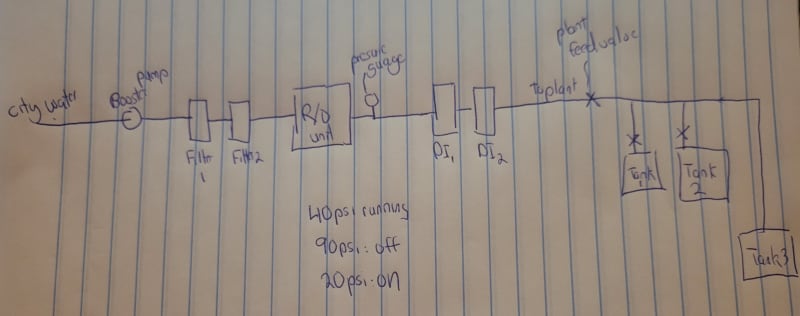cames
Industrial
- Nov 8, 2022
- 6
Hi all,
We currently have an RO unit (~25 years old), the piping setup follows little sketch I drew attached to this post.
Basically, theres city water that goes thru a booster pump then feeds 2 filters then feeds the RO Unit.
The RO unit then passes DI water thru two DI beds and thru a plant feed valve which then feeds the Water to 3 holding tanks. The plant feed valve is roughly 100 feet away from the RO unit.
The tank has a high and low level sensor, when the tanks low sensor turns on the plant feed valve opens which fills the tanks until the high level sensor is activated, then the plant feed valve closes.
Increased pressure in the line causes the RO unit to stop. There is a pressure gauge on the outlet of the RO unit that turns the RO unit off when pressure is greater than 90 psi (meaning the feed water valve has been closed). When the tanks low level switch is activated the plant feed valve is open lowering the pressure in the pipe below 20 which then triggers the RO unit to turn on. Rinse and repeat.
This RO unit has been running this way for the past 25 years, its only being now replaced since the PLC system is on the brink of death.
Anywho, we wanted to install the new RO unit right where this old unit is and keep the communication the same..however the RO manufacturer states that back pressure can cause damage to the RO unit and recomennds using a breaker tank and pump after the RO unit.
What is everyone thoughts? is the back pressure really that much of an iessue? is there another instrument that can be used as a trigger other than back pressure? since the plant water feed valve is 100 ft away from the unit will the water hammer from the back pressure be too far away to not have any effect on the unit?
Thank you
We currently have an RO unit (~25 years old), the piping setup follows little sketch I drew attached to this post.
Basically, theres city water that goes thru a booster pump then feeds 2 filters then feeds the RO Unit.
The RO unit then passes DI water thru two DI beds and thru a plant feed valve which then feeds the Water to 3 holding tanks. The plant feed valve is roughly 100 feet away from the RO unit.
The tank has a high and low level sensor, when the tanks low sensor turns on the plant feed valve opens which fills the tanks until the high level sensor is activated, then the plant feed valve closes.
Increased pressure in the line causes the RO unit to stop. There is a pressure gauge on the outlet of the RO unit that turns the RO unit off when pressure is greater than 90 psi (meaning the feed water valve has been closed). When the tanks low level switch is activated the plant feed valve is open lowering the pressure in the pipe below 20 which then triggers the RO unit to turn on. Rinse and repeat.
This RO unit has been running this way for the past 25 years, its only being now replaced since the PLC system is on the brink of death.
Anywho, we wanted to install the new RO unit right where this old unit is and keep the communication the same..however the RO manufacturer states that back pressure can cause damage to the RO unit and recomennds using a breaker tank and pump after the RO unit.
What is everyone thoughts? is the back pressure really that much of an iessue? is there another instrument that can be used as a trigger other than back pressure? since the plant water feed valve is 100 ft away from the unit will the water hammer from the back pressure be too far away to not have any effect on the unit?
Thank you

